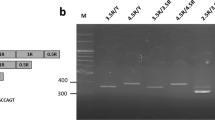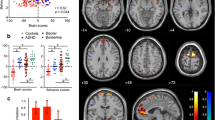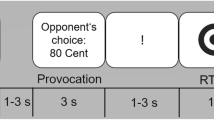Abstract
Emotional reactivity and regulation are fundamental to human behavior. As inter-individual behavioral variation is affected by a multitude of different genes, there is intense interest to investigate gene–gene effects. Functional sequence variation at two genes has been associated with response and resiliency to emotionally unpleasant stimuli. These genes are the catechol-O-methyltransferase gene (COMT Val158Met) and the regulatory region (5-HTTLPR) of the serotonin transporter gene. Recently, it has been proposed that 5-HTT expression is not only affected by the common S/L variant of 5-HTTLPR but also by an A to G substitution. Using functional magnetic resonance imaging, we assessed the effects of COMT Val158Met and both 5-HTT genotypes on brain activation by standardized affective visual stimuli (unpleasant, pleasant, and neutral) in 48 healthy subjects. Based on previous studies, the analysis of genotype effects was restricted to limbic brain areas. To determine allele-dose effects, the number of COMT Met158 alleles (i.e., lower activity of COMT) and the number of 5-HTT low expressing alleles (S and G) was correlated with the blood oxygen level-dependent (BOLD) response to pleasant or unpleasant stimuli compared to neutral stimuli. We observed an additive effect of COMT and both 5-HTT polymorphisms, accounting for 40% of the inter-individual variance in the averaged BOLD response of amygdala, hippocampal and limbic cortical regions elicited by unpleasant stimuli. Effects of 5-HTT and COMT genotypes did not affect brain processing of pleasant stimuli. These data indicate that functional brain imaging may be used to assess the interaction of multiple genes on the function of neuronal networks.
This is a preview of subscription content, access via your institution
Access options
Subscribe to this journal
Receive 12 print issues and online access
$259.00 per year
only $21.58 per issue
Buy this article
- Purchase on Springer Link
- Instant access to full article PDF
Prices may be subject to local taxes which are calculated during checkout


Similar content being viewed by others
References
Goldman D, Oroszi G, Ducci F . The genetics of addictions: uncovering the genes. Nat Rev Genet 2005; 6: 521–532.
Gottesman II, Gould TD . The endophenotype concept in psychiatry: etymology and strategic intentions. Am J Psychiatry 2003; 160: 636–645.
Schumann G, Spanagel R, Mann K . Candidate genes for alcohol dependence: animal studies. Alcohol Clin Exp Res 2003; 27: 880–888.
Lachman HM, Papolos DF, Saito T, Yu YM, Szumlanski CL, Weinshilboum RM . Human catechol-O-methyltransferase pharmacogenetics: description of a functional polymorphism and its potential application to neuropsychiatric disorders. Pharmacogenetics 1996; 6: 243–250.
Weinshilboum RM, Otterness DM, Szumlanski CL . Methylation pharmacogenetics: catechol O-methyltransferase, thiopurine methyltransferase, and histamine N-methyltransferase. Annu Rev Pharmacol Toxicol 1999; 39: 19–52.
Palmatier MA, Kang AM, Kidd KK . Global variation in the frequencies of functionally different catechol-O-methyltransferase alleles. Biol Psychiatry 1999; 46: 557–567.
Lotta T, Vidgren J, Tilgmann C, Ulmanen I, Melen K, Julkunen I et al. Kinetics of human soluble and membrane-bound catechol O-methyltransferase: a revised mechanism and description of the thermolabile variant of the enzyme. Biochemistry 1995; 34: 4202–4210.
Spielman RS, Weinshilboum RM . Genetics of red cell COMT activity: analysis of thermal stability and family data. Am J Med Genet 1981; 10: 279–290.
Egan MF, Goldberg TE, Kolachana BS, Callicott JH, Mazzanti CM, Straub RE et al. Effect of COMT Val108/158 Met genotype on frontal lobe function and risk for schizophrenia. Proc Natl Acad Sci USA 2001; 98: 6917–6922.
Joober R, Gauthier J, Lal S, Bloom D, Lalonde P, Rouleau G et al. Catechol-O-methyltransferase Val-108/158-Met gene variants associated with performance on the Wisconsin Card Sorting Test. Arch Gen Psychiatry 2002; 59: 662–663.
Malhotra AK, Kestler LJ, Mazzanti C, Bates JA, Goldberg T, Goldman D . A functional polymorphism in the COMT gene and performance on a test of prefrontal cognition. Am J Psychiatry 2002; 159: 652–654.
Goldberg TE, Egan MF, Gscheidle T, Coppola R, Weickert T, Kolachana BS et al. Executive subprocesses in working memory: relationship to catechol-O-methyltransferase Val158Met genotype and schizophrenia. Arch Gen Psychiatry 2003; 60: 889–896.
Mynett-Johnson LA, Murphy VE, Claffey E, Shields DC, McKeon P . Preliminary evidence of an association between bipolar disorder in females and the catechol-O-methyltransferase gene. Psychiatr Genet 1998; 8: 221–225.
Ohara K, Nagai M, Suzuki Y, Ohara K . Low activity allele of catechol-o-methyltransferase gene and Japanese unipolar depression. Neuroreport 1998; 9: 1305–1308.
Papolos DF, Veit S, Faedda GL, Saito T, Lachman HM . Ultra-ultra rapid cycling bipolar disorder is associated with the low activity catecholamine-O-methyltransferase allele. Mol Psychiatry 1998; 3: 346–349.
Enoch MA, Schuckit MA, Johnson And BA, Goldman D . Genetics of alcoholism using intermediate phenotypes. Alcohol Clin Exp Res 2003; 27: 169–176.
Zubieta JK, Heitzeg MM, Smith YR, Bueller JA, Xu K, Xu Y et al. COMT val158met genotype affects mu-opioid neurotransmitter responses to a pain stressor. Science 2003; 299: 1240–1243.
Diatchenko L, Slade GD, Nackley AG, Bhalang K, Sigurdsson A, Belfer I et al. Genetic basis for individual variations in pain perception and the development of a chronic pain condition. Hum Mol Genet 2005; 14: 135–143.
Enoch MA, Xu K, Ferro E, Harris CR, Goldman D . Genetic origins of anxiety in women: a role for a functional catechol-O-methyltransferase polymorphism. Psychiatr Genet 2003; 13: 33–41.
Lesch KP, Bengel D, Heils A, Sabol SZ, Greenberg BD, Petri S et al. Association of anxiety-related traits with a polymorphism in the serotonin transporter gene regulatory region. Science 1996; 274: 1527–1531.
Heinz A, Jones DW, Mazzanti C, Goldman D, Ragan P, Hommer D et al. A relationship between serotonin transporter genotype and in vivo protein expression and alcohol neurotoxicity. Biol Psychiatry 2000; 47: 643–649.
Nakamura M, Ueno S, Sano A, Tanabe H . The human serotonin transporter gene linked polymorphism (5-HTTLPR) shows ten novel allelic variants. Mol Psychiatry 2000; 5: 32–38.
Kim SJ, Cox N, Courchesne R, Lord C, Corsello C, Akshoomoff N et al. Transmission disequilibrium mapping at the serotonin transporter gene (SLC6A4) region in autistic disorder. Mol Psychiatry 2002; 7: 278–288.
Kraft JB, Slager SL, McGrath PJ, Hamilton SP . Sequence analysis of the serotonin transporter and associations with antidepressant response. Biol Psychiatry 2005; 58: 374–381.
Hu XZ, Lipsky RH, Zhu G, Akhtar LA, Taubman J, Greenberg BD et al. Serotonin transporter promoter gain-of-function genotypes are linked to obsessive-compulsive disorder. Am J Hum Genet 2006; 78: 815–826.
Garpenstrand H, Annas P, Ekblom J, Oreland L, Fredrikson M . Human fear conditioning is related to dopaminergic and serotonergic biological markers. Behav Neurosci 2001; 115: 358–364.
Caspi A, Sugden K, Moffitt TE, Taylor A, Craig IW, Harrington H et al. Influence of life stress on depression: moderation by a polymorphism in the 5-HTT gene. Science 2003; 301: 386–389.
Barr CS, Newman TK, Lindell S, Shannon C, Champoux M, Lesch KP et al. Interaction between serotonin transporter gene variation and rearing condition in alcohol preference and consumption in female primates. Arch Gen Psychiatry 2004; 61: 1146–1152.
Beitchman JH, Baldassarra L, Mik H, De LV, King N, Bender D et al. Serotonin transporter polymorphisms and persistent, pervasive childhood aggression. Am J Psychiatry 2006; 163: 1103–1105.
Hu X, Oroszi G, Chun J, Smith TL, Goldman D, Schuckit MA . An expanded evaluation of the relationship of four alleles to the level of response to alcohol and the alcoholism risk. Alcohol Clin Exp Res 2005; 29: 8–16.
Stein MB, Seedat S, Gelernter J . Serotonin transporter gene promoter polymorphism predicts SSRI response in generalized social anxiety disorder. Psychopharmacology (Berlin) 2006; 187: 68–72.
Gelernter J, Kranzler H, Cubells JF . Serotonin transporter protein (SLC6A4) allele and haplotype frequencies and linkage disequilibria in African- and European-American and Japanese populations and in alcohol-dependent subjects. Hum Genet 1997; 101: 243–246.
Strobel A, Lesch KP, Jatzke S, Paetzold F, Brocke B . Further evidence for a modulation of novelty seeking by DRD4 exon III, 5-HTTLPR, and COMT val/met variants. Mol Psychiatry 2003; 8: 371–372.
Benjamin J, Osher Y, Lichtenberg P, Bachner-Melman R, Gritsenko I, Kotler M et al. An interaction between the catechol O-methyltransferase and serotonin transporter promoter region polymorphisms contributes to tridimensional personality questionnaire persistence scores in normal subjects. Neuropsychobiology 2000; 41: 48–53.
Benjamin J, Osher Y, Kotler M, Gritsenko I, Nemanov L, Belmaker RH et al. Association between tridimensional personality questionnaire (TPQ) traits and three functional polymorphisms: dopamine receptor D4 (DRD4), serotonin transporter promoter region (5-HTTLPR) and catechol O-methyltransferase (COMT). Mol Psychiatry 2000; 5: 96–100.
Hariri AR, Mattay VS, Tessitore A, Kolachana B, Fera F, Goldman D et al. Serotonin transporter genetic variation and the response of the human amygdala. Science 2002; 297: 400–403.
Heinz A, Braus DF, Smolka MN, Wrase J, Puls I, Hermann D et al. Amygdala-prefrontal coupling depends on a genetic variation of the serotonin transporter. Nat Neurosci 2005; 8: 20–21.
Smolka MN, Schumann G, Wrase J, Grüsser SM, Flor H, Mann K et al. Catechol O-methyltransferase val158-met genotype affects processing of emotional stimuli in the amygdala and prefrontal cortex. J Neurosci 2005; 25: 836–842.
Pezawas L, Meyer-Lindenberg A, Drabant EM, Verchinski BA, Munoz KE, Kolachana BS et al. 5-HTTLPR polymorphism impacts human cingulate–amygdala interactions: a genetic susceptibility mechanism for depression. Nat Neurosci 2005; 8: 828–834.
First MB, Spitzer RL, Gibbon M, Williams JBW . Structured Clinical Interview for DSM-IV-TR Axis I Disorders, Research Version, Patient Edition (SCID-I/P). Biometrics Research, New York State Psychiatric Institute: New York, 2001.
First MB, Spitzer RL, Gibbon M, Williams JBW . Structured Clinical Interview for DSM-IV Personality Disorders, (SCID-II). American Psychiatric Press, Inc.: Washington, DC, 1997.
Derogatis LR . Symptom Checklist 90-Revised/SCL-90-R: Administration, Scoring and Procedures Manual II. Clinical Psychometric Research: Baltimore, MD, 1983.
Spielberger CD, Gorsuch RL, Lushene RE . Manual for the State-Trait-Anxiety Inventory. Consulting Psychologists Press: Palo Alto, CA, USA, 1970.
Radloff LS . The CES-D scale: a self report depression scale for research in the general population. Appl Psychol Meas 1997; 1: 385–401.
Hamilton M . The Hamilton Rating Scale for Depression in Assessment of Depression. Springer: Berlin, 1986, pp 143–152.
Lang PJ, Bradley MM, Cuthbert BN . The International Affective Picture System (IAPS). Center for Research in Psychophysiology, University of Florida: Gainsville, FL, 1999.
Lang PJ . The emotion probe. Studies of motivation and attention. Am Psychol 1995; 50: 372–385.
Taylor SF, Phan KL, Decker LR, Liberzon I . Subjective rating of emotionally salient stimuli modulates neural activity. Neuroimage 2003; 18: 650–659.
Bradley MM, Lang PJ . Measuring emotion: the self-assessment manikin and the semantic differential. J Behav Ther Exp Psychiatry 1994; 25: 49–59.
Wendland JR, Martin BJ, Kruse MR, Lesch KP, Murphy DL . Simultaneous genotyping of four functional loci of human SLC6A4, with a reappraisal of 5-HTTLPR and rs25531. Mol Psychiatry 2006; 11: 224–226.
Maldjian JA, Laurienti PJ, Kraft RA, Burdette JH . An automated method for neuroanatomic and cytoarchitectonic atlas-based interrogation of fMRI data sets. Neuroimage 2003; 19: 1233–1239.
Tzourio-Mazoyer N, Landeau B, Papathanassiou D, Crivello F, Etard O, Delcroix N et al. Automated anatomical labeling of activations in SPM using a macroscopic anatomical parcellation of the MNI MRI single-subject brain. Neuroimage 2002; 15: 273–289.
Genovese CR, Lazar NA, Nichols T . Thresholding of statistical maps in functional neuroimaging using the false discovery rate. Neuroimage 2002; 15: 870–878.
Hariri AR, Weinberger DR . Imaging genomics. Br Med Bull 2003; 65: 259–270.
Murray CJ, Lopez AD . Global mortality, disability, and the contribution of risk factors: Global Burden of Disease Study. Lancet 1997; 349: 1436–1442.
Delgado PL . Depression: the case for a monoamine deficiency. J Clin Psychiatry 2000; 61 (Suppl 6): 7–11.
Hariri AR, Drabant EM, Munoz KE, Kolachana BS, Mattay VS, Egan MF et al. A susceptibility gene for affective disorders and the response of the human amygdala. Arch Gen Psychiatry 2005; 62: 146–152.
Rosenkranz JA, Grace AA . Modulation of basolateral amygdala neuronal firing and afferent drive by dopamine receptor activation in vivo. J Neurosci 1999; 19: 11027–11039.
Hariri AR, Mattay VS, Tessitore A, Fera F, Smith WG, Weinberger DR . Dextroamphetamine modulates the response of the human amygdala. Neuropsychopharmacology 2002; 27: 1036–1040.
Tessitore A, Hariri AR, Fera F, Smith WG, Chase TN, Hyde TM et al. Dopamine modulates the response of the human amygdala: a study in Parkinson's disease. J Neurosci 2002; 22: 9099–9103.
Akil M, Kolachana BS, Rothmond DA, Hyde TM, Weinberger DR, Kleinman JE . Catechol-O-methyltransferase genotype and dopamine regulation in the human brain. J Neurosci 2003; 23: 2008–2013.
Meyer-Lindenberg A, Kohn PD, Kolachana B, Kippenhan S, McInerney-Leo A, Nussbaum R et al. Midbrain dopamine and prefrontal function in humans: interaction and modulation by COMT genotype. Nat Neurosci 2005; 8: 594–596.
Bremner JD, Krystal JH, Southwick SM, Charney DS . Noradrenergic mechanisms in stress and anxiety: I. Preclinical studies. Synapse 1996; 23: 28–38.
Lopez JF, Akil H, Watson SJ . Neural circuits mediating stress. Biol Psychiatry 1999; 46: 1461–1471.
McNaughton N, Gray JA . Anxiolytic action on the behavioural inhibition system implies multiple types of arousal contribute to anxiety. J Affect Disord 2000; 61: 161–176.
Phillips ML, Drevets WC, Rauch SL, Lane R . Neurobiology of emotion perception I: The neural basis of normal emotion perception. Biol Psychiatry 2003; 54: 504–514.
Canli T, Omura K, Haas BW, Fallgatter A, Constable RT, Lesch KP . Beyond affect: a role for genetic variation of the serotonin transporter in neural activation during a cognitive attention task. Proc Natl Acad Sci USA 2005; 102: 12224–12229.
Santarelli L, Saxe M, Gross C, Surget A, Battaglia F, Dulawa S et al. Requirement of hippocampal neurogenesis for the behavioral effects of antidepressants. Science 2003; 301: 805–809.
Acknowledgements
This study was supported by the Deutsche Forschungsgemeinschaft (He 2597/7-3, Sm 80/1-1 & SFB 636/C1) and the German Ministry of Education and Research (NGFN-2 No. 01 GS 0475, Baden-Württemberg Consortium for Addiction Research No. 01 EB 0110/0410).
Author information
Authors and Affiliations
Corresponding author
Rights and permissions
About this article
Cite this article
Smolka, M., Bühler, M., Schumann, G. et al. Gene–gene effects on central processing of aversive stimuli. Mol Psychiatry 12, 307–317 (2007). https://doi.org/10.1038/sj.mp.4001946
Received:
Revised:
Accepted:
Published:
Issue Date:
DOI: https://doi.org/10.1038/sj.mp.4001946
Keywords
This article is cited by
-
Serotonin transporter polymorphism moderates the effects of caregiver intrusiveness on ADHD symptoms among institutionalized preschoolers
European Child & Adolescent Psychiatry (2017)
-
Effects of the 5-HTTLPR Polymorphism of the Serotonin Transporter Gene on the Recognition of Mimicked Emotional Expressions in Schizophrenia
Neuroscience and Behavioral Physiology (2015)
-
Therapygenetics: anterior cingulate cortex–amygdala coupling is associated with 5-HTTLPR and treatment response in panic disorder with agoraphobia
Journal of Neural Transmission (2015)
-
Complex Multilocus Effects of Catechol-O-Methyltransferase Haplotypes Predict Pain and Pain Interference 6 Weeks After Motor Vehicle Collision
NeuroMolecular Medicine (2014)
-
Sex Differences in COMT Polymorphism Effects on Prefrontal Inhibitory Control in Adolescence
Neuropsychopharmacology (2014)



